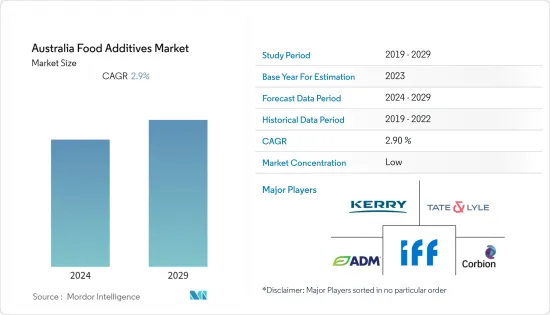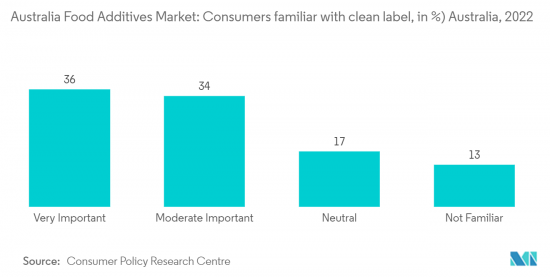Need help finding what you are looking for?
Contact Us
PUBLISHER: Mordor Intelligence | PRODUCT CODE: 1403846

PUBLISHER: Mordor Intelligence | PRODUCT CODE: 1403846
Australia Food Additives - Market Share Analysis, Industry Trends & Statistics, Growth Forecasts 2024 - 2029
PUBLISHED:
PAGES: 90 Pages
DELIVERY TIME: 2-3 business days
SELECT AN OPTION

The Australian food additives market is valued at USD 2.4 billion and is projected to register a CAGR of 2.9% during the forecast period.
Key Highlights
- The food additives market is primarily driven by the expanding processed food market and the increasing penetration of the organized retail sector. Growing disposable incomes, working population, and busy lives move consumers toward convenience food. However, increasing consumer awareness of chemical additives' adverse impacts is pressuring the food and beverage industry to introduce the natural additives category. The complex regulatory environment is another major restraint in the market.
- Moreover, the high rate of diabetic patients in the country has led to the growth of alternative sweeteners such as sucralose due to their beneficial factors. As per the Australia Institute of Health and Welfare data, in 2021, an estimated 1 in 20 around 1.3 million Australians were living with diabetes. Various studies have depicted that sucralose has limited to no effect on factors like carbohydrate metabolism and insulin secretion. Moreover, the exceptional stability of sucralose helps food manufacturers and consumers use it virtually anywhere sugar is used, including cooking and baking processes. The sucralose market is expected to grow with the drastic price reduction due to excessive supply from international players. Granulated sucralose sweeteners are used as a spoon for spoon replacement for sugar.
Australia Food Additives Market Trends
Rising Popularity for Clean Label Ingredients
- Consumers demand clean labels on products to learn about the product they are about to consume and at what level. Their interest in identifying the ingredients in food and beverage products has triggered the growth of the clean-label ingredient market.
- Consumers are highly concerned about the long-term effects of the elements they consume regarding nutrition content and their impact on health, environmental sustainability, sourcing, and social responsibility. This has triggered the increasing demand for the clean-label ingredient market. Despite the price difference, they are trying to avoid consuming products that contain synthetic ingredients, as various published studies indicate that natural ingredients help prevent hyperactivity disorders and behavioral issues in children, among other benefits.
- Moreover, several organizations like the Food and Drug Administration (FDA), the World Health Organization (WHO), and many more are constantly involved in the introduction of the General Standard for Food Additives (GSFA) to establish common safety standards, thus, increasing trading of the ingredients in the country.
- Major national and international players are also participating in clean-label initiatives. For instance, in March 2022, DSM launched DelvoGuardcultures, targeting producers looking for clean-label solutions. It also provided them with a solution to extend the shelf life of their dairy products, such as yogurt, fresh cheese, and sour cream.

Increased Utilization in Beverages
- The use of preservatives in the beverage industry is to avoid the change in taste, color of drinks, and bitter aftertaste. Soft drinks are high in water activity, and some rich in vitamins and minerals, so they are an attractive environment for microbes. The usually low pH of the soft drinks, carbonation, sugar content in some of them, and the addition of preservatives help to inhibit the growth of microbes and bacteria.
- The type of chemical preservatives used in beverages depends on the chemical and physical properties of both the antimicrobial preservatives and the beverage type. Some of the most common and significant food additives added to the beverage segment are food flavors, colors, and sweeteners, such as high fructose corn syrup and food enzymes. There is also a broad application of enzymes in the brewing industries. Enactments like cellulase, alpha-amylase, and beta-glucanase are used for better malt separation, extraction yield, and beer filtration and stabilization.
- Moreover, brewers are also starting to experiment with their region's dazzling array of tropical fruits. The winemakers are introducing new innovative flavors to attract more consumers and strengthen their market position. Similarly, due to the rising health concern, consumers are inclined toward natural sweeteners like Stevia. It is widely used in beverages, such as teas, coffees, soft drinks, flavored waters, juices, and alcoholic beverages. Stevia solutions formulated for specific beverage applications can provide a superior, clean, sugar-like taste with reduced linger. Stevia's rapid growth in the beverage market is a testament to its many benefits, including zero calories, 100% natural origin, and being non-caloric, tooth-friendly, non-fermenting, highly soluble, and pH, heat, photo (light), and shelf-stable.
Australia Food Additives Industry Overview
The Australian food additives market is fragmented with the presence of numerous players. The key players focus on product innovations, expansions, partnerships, and mergers and acquisitions to meet growing consumer needs. The major players in the market are Archer Daniels Midland Company, Corbion NV, Kerry Group, Tate & Lyle PLC, and International Flavors and Fragrances.
Additional Benefits:
- The market estimate (ME) sheet in Excel format
- 3 months of analyst support
Product Code: 51822
TABLE OF CONTENTS
1 INTRODUCTION
- 1.1 Study Assumptions and Market Definition
- 1.2 Scope of the Study
2 RESEARCH METHODOLOGY
3 EXECUTIVE SUMMARY
- 3.1 Market Overview
4 MARKET DYNAMICS
- 4.1 Market Drivers
- 4.1.1 Increasing Demand For Convenience & Processed Food
- 4.2 Market Restraints
- 4.2.1 Increased Consumer Awareness On Side-Effects Of Chemical Additives
- 4.3 Porter's Five Forces Analysis
- 4.3.1 Threat of New Entrants
- 4.3.2 Bargaining Power of Buyers/Consumers
- 4.3.3 Bargaining Power of Suppliers
- 4.3.4 Threat of Substitute Products
- 4.3.5 Intensity of Competitive Rivalry
5 MARKET SEGMENTATION
- 5.1 Type
- 5.1.1 Preservatives
- 5.1.2 Sweeteners and Sugar Substitutes
- 5.1.3 Emulsifiers
- 5.1.4 Enzymes
- 5.1.5 Hydrocolloids
- 5.1.6 Food Flavors and Enhancers
- 5.1.7 Food Colorants
- 5.1.8 Other Types
- 5.2 Application
- 5.2.1 Bakery and Confectionery
- 5.2.2 Dairy and Frozen Products
- 5.2.3 Beverages
- 5.2.4 Meat Products
- 5.2.5 Other Applications
6 COMPETITIVE LANDSCAPE
- 6.1 Most Adopted Strategies
- 6.2 Market Share Analysis
- 6.3 Company Profiles
- 6.3.1 Archer Daniels Midland Company
- 6.3.2 Corbion NV
- 6.3.3 Tate & Lyle PLC
- 6.3.4 Kerry Group
- 6.3.5 Firmenich
- 6.3.6 BASE SE
- 6.3.7 International Flavors and Fragrances
- 6.3.8 Koninklike DSM NV
- 6.3.9 Givaudan SA
- 6.3.10 CHR Hansen Holding A/S
7 MARKET OPPORTUNITIES AND FUTURE TRENDS
Have a question?


SELECT AN OPTION
Have a question?


Questions? Please give us a call or visit the contact form.
